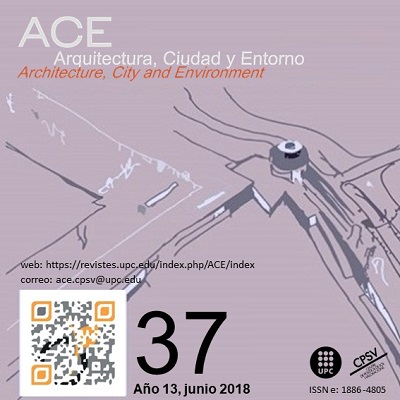Graphic assessment of the urban rehabilitation of Caño Roto protected estate
DOI:
https://doi.org/10.5821/ace.13.37.4885Keywords:
Protected housing, urban regeneration, urban planning, analysisAbstract
Objective
The objective of this study is to test the applicability of a graphical assessment methodology of urban interventions, through the evaluation of a case study: the rehabilitation of Caño Roto protected estate (built in 1957-1963 and rehabilitated in 1994-2004).
Methodology
The method allows to synthesize graphically all the points that define the state of protected housing neighbourhoods and the interventions in order to achieve their urban regeneration. It is carried out by drawing up a diagnosis, to extract the initial opportunity and threat factors, and an evaluation of the process, to highlight its success and failure factors.
Conclusions
Its application to the case study shows the competence of the method to define its most relevant aspects. The intervention process itself and the issues related to the constructive criteria stand out as success factors. Issues related to the estate integration, its urban complexity, and its typological and patrimonial criteria are reflected as the most important shortcomings.
Originality
By showing errors and successes of the developed operations, this type of evaluation gives the keys to optimize them, so it can be applied in the planning of new interventions as a prospective instrument capable of establishing technical criteria in decision making.
Downloads
Published
Issue
Section
License
| INTELECTUAL PROTECTION CRITERIA |
At this moment, it is count with the "Oficina Española de Patentes y Marcas", while global protection it is being processed by the World Intelectual Property Organization (OMPI/WIPO). Nevertheless the International Standard Serial Number Office (ISSN) has given the following numbers ISSN: 1886-4805 (electronic version) and 1887-7052 (paper version). All articles will be peer reviewed, using double blind reviewing. |
| COPYRIGHT |
The article contents and their comments are authors exclusive liability, and do not reflect necessarily the journal editor commitee's opinion. All ACE published works are subject to the following licence CC BY-NC-ND 3.0 ES http://creativecommons.org/licenses/by-nc-nd/3.0/es/ It implies that authors do not hold nor retain the copyright without restrictions but only those included in the licence. |


































